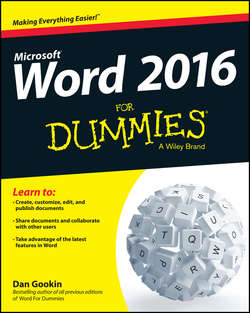Читать книгу Word 2016 For Dummies - Gookin Dan - Страница 5
Part I
Your Introduction to Word
Chapter 1
Hello, Word!
Start Your Word Day
ОглавлениеAs computer software, Microsoft Word dwells in the realm of Windows. To get work done in Word, you must contend with the multitudinous ways available in Windows to run the Word program. These methods can vary from the obvious to the obnoxiously cryptic, so instead I present you with the three most common ways to start your Word day.
✔ Before you can use Word, your computer must be on and ready to work. So turn on your PC, laptop, or tablet if it’s not already on and toasty. Log into Windows.
✔ Do not attempt to make toast in your computer.
✔ Ensure that you sport a proper posture as you write. Your wrists should be even with your elbows. Your head should tilt down only slightly, although it’s best to look straight ahead. Keep your shoulders back and relaxed. Have a minion gently massage your feet.
Starting Word the traditional way
Propriety demands that I show the traditional, boring way to start Word. Let me be quick:
1. Press the Windows key on the keyboard.
The Windows key is adorned with the Windows logo icon, which I won’t illustrate here because it’s changed over the years. The key is nestled between the Ctrl and Alt keys to the left of the spacebar. A duplicate is found on the right side of the spacebar. Use either key.
2. Look for Microsoft Word on the Start menu.
The item might be titled Word or Word 2016 or something similar.
If you don’t find Word right away in Windows 10, click the All Apps button to hunt it down. In Windows 7, click the All Programs button.
Sometimes Word is found on a Microsoft Office or Office 2016 submenu.
3. Click the Word icon or button to start the program.
Watch in amazement as the program unfurls on the screen.
Starting Word the best way
The best way to start Word, and the way I do it every day, is to click the Word icon on the taskbar. Word starts simply and quickly.
The issue, of course, is how to get the Word icon on the taskbar. Follow these steps:
1. Find the Word icon on the Start button’s All Programs menu.
See the preceding section, Steps 1 and 2.
2. Right-click the Word icon.
3. Choose the command Pin to Taskbar.
The Word icon is pinned (permanently added) to the taskbar.
Starting Word in Windows 8 (for the few who still use Windows 8)
One of the reasons Windows 8 was so aggressively unpopular was that it eschewed the traditional Start button menu for a tile-based Start screen. If you’re still burdened with Windows 8, or you run Windows 10 in Tablet mode, start Word by pressing the Windows key on the keyboard and then clicking the Word 2016 tile on the Start screen.
You can stick the Word icon to the taskbar, as described in this chapter: Click the Word tile on the Start screen and then choose the command Pin to Taskbar. (The Pin to Taskbar command is at the bottom of the screen.)
Opening a document to start Word
You use the Word program to create documents, which are stored on your computer in much the same way as people pile junk into boxes and store them in their garages. To start Word, open a document. Follow these steps:
1. Locate the document icon.
Use your Windows kung fu to open the proper folders and hunt down a Word document icon, similar to what’s shown in the margin.
2. Double-click the icon.
This step is a standard Word operation: Double-click an icon to open a program. In this case, opening a Word document starts Word.
The document is opened and presented on the screen, ready for whatever.
✔ You use Word to create documents. They’re saved to storage on your computer or in the cloud. Details are offered in Chapter 8.
✔ The document name is assigned when it’s originally saved. Use the name to determine the document’s contents – providing that it was properly named when first saved.
✔ Document icons are managed by Windows. If you need to find a lost document, rename it, or organize your documents into a folder, you use Windows, not Word.
